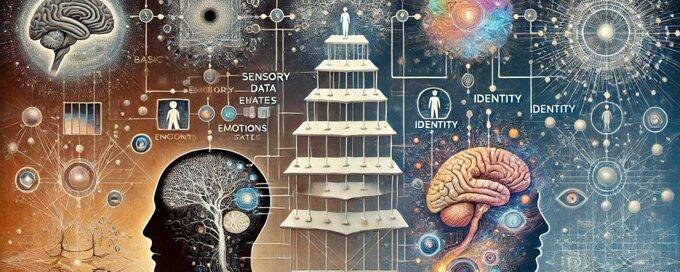SamuelGabrielSG on Nostr: Hierarchy and Heterarchy in Consciousness Understanding consciousness involves ...
Hierarchy and Heterarchy in Consciousness
Understanding consciousness involves exploring the structures that organize our thoughts, perceptions, and experiences. Two crucial concepts in this exploration are hierarchy and heterarchy. These systems provide different frameworks for how information and experiences are structured and understood within the mind.
Hierarchy:
Definition and Importance:Hierarchy is a system where elements are ranked according to levels of importance or authority. This structure is prevalent in various domains, including organizational, biological, and cognitive systems. In consciousness, hierarchy helps us organize our thoughts and experiences from the most basic to the most complex.
Application in Consciousness:In the realm of consciousness, hierarchy plays a crucial role in structuring our mental processes. For instance, basic sensory data such as seeing or hearing forms the foundation, while higher-level processes like abstract thinking and self-reflection build upon these fundamental experiences. This hierarchical organization allows for a clear progression from simple to complex mental activities.
Advantages:
Clarity and Order: Hierarchical structures provide a clear and organized framework, making it easier to understand and navigate complex systems.
Efficiency: Decision-making and problem-solving processes are often more efficient within a clear hierarchical structure, as it helps prioritize information and actions.
Control: Hierarchies allow for better management and control of various elements within a system, facilitating systematic and ordered processing of information.
Examples in Consciousness:Visual Perception: At the base level of hierarchy, visual perception involves simple recognition of shapes and colors.
Emotional States: Moving up the hierarchy, emotional states involve complex interpretations and responses to stimuli.
Identity: At the top level, identity encompasses self-concept and existential reflections, integrating various lower-level experiences and interpretations into a coherent sense of self.
Heterarchy:
Definition and Importance:Heterarchy refers to a system where elements are unranked or can be ranked in multiple ways. This structure allows for greater flexibility and adaptability compared to strict hierarchies. In consciousness, heterarchy supports a more dynamic and interconnected understanding of thoughts and experiences.
Application in Consciousness:Heterarchical structures in consciousness allow for multiple perspectives and interpretations of experiences. Unlike hierarchical systems, heterarchies do not prioritize one element over another, fostering a more holistic and interconnected approach to mental processes.
Advantages:Flexibility: Heterarchical systems are adaptable to changing situations and new information, making them highly dynamic.
Creativity: Encourages multiple viewpoints and innovative thinking by not confining thoughts and experiences to a rigid structure.
Collaboration: Promotes equal participation and input from various elements within the system, enhancing collaborative efforts and integration of diverse ideas.
Examples in Consciousness:Multisensory Integration: In a heterarchical system, visual, auditory, and tactile information are combined equally, without prioritizing one sense over another.
Emotional Complexity: Recognizing that emotions can be multifaceted and not easily ranked, allowing for a more nuanced understanding of emotional states.
Identity and Roles: Understanding that one's identity can have multiple, equally important aspects, such as being a parent, professional, and friend simultaneously.
Hybrid Structures:
Combining Hierarchy and Heterarchy:Many systems, including consciousness, benefit from a combination of hierarchical and heterarchical structures. This hybrid approach leverages the strengths of both systems to create a more robust and adaptive framework.
Application in Consciousness:Hybrid structures in consciousness allow for both ordered thinking and flexible, creative problem-solving. For example, logical reasoning may follow a hierarchical structure, while brainstorming and creative thinking benefit from a heterarchical approach.
Examples:Problem-Solving: Using a hierarchical approach to structure the problem while employing a heterarchical approach to explore potential solutions.
Learning and Adaptation: Foundational knowledge can be structured hierarchically, while exploration of advanced topics can follow a heterarchical pattern.
Social Roles and Interactions: Balancing structured social roles with the flexibility to adapt to different social contexts.
Key Takeaways:
Hierarchy provides clarity, efficiency, and control in organizing experiences.
Heterarchy offers flexibility, creativity, and collaborative potential in understanding consciousness.
Hybrid Structures combine the strengths of both to create a more comprehensive and adaptive system for navigating human consciousness.
Understanding the interplay between hierarchy and heterarchy in consciousness offers a richer and more nuanced comprehension of how we process and organize our thoughts and experiences. This framework helps explain the complexity of human cognition and the adaptive nature of our mental processes, highlighting the importance of both structured and flexible approaches in achieving a well-rounded and effective understanding of consciousness.

Understanding consciousness involves exploring the structures that organize our thoughts, perceptions, and experiences. Two crucial concepts in this exploration are hierarchy and heterarchy. These systems provide different frameworks for how information and experiences are structured and understood within the mind.
Hierarchy:
Definition and Importance:Hierarchy is a system where elements are ranked according to levels of importance or authority. This structure is prevalent in various domains, including organizational, biological, and cognitive systems. In consciousness, hierarchy helps us organize our thoughts and experiences from the most basic to the most complex.
Application in Consciousness:In the realm of consciousness, hierarchy plays a crucial role in structuring our mental processes. For instance, basic sensory data such as seeing or hearing forms the foundation, while higher-level processes like abstract thinking and self-reflection build upon these fundamental experiences. This hierarchical organization allows for a clear progression from simple to complex mental activities.
Advantages:
Clarity and Order: Hierarchical structures provide a clear and organized framework, making it easier to understand and navigate complex systems.
Efficiency: Decision-making and problem-solving processes are often more efficient within a clear hierarchical structure, as it helps prioritize information and actions.
Control: Hierarchies allow for better management and control of various elements within a system, facilitating systematic and ordered processing of information.
Examples in Consciousness:Visual Perception: At the base level of hierarchy, visual perception involves simple recognition of shapes and colors.
Emotional States: Moving up the hierarchy, emotional states involve complex interpretations and responses to stimuli.
Identity: At the top level, identity encompasses self-concept and existential reflections, integrating various lower-level experiences and interpretations into a coherent sense of self.
Heterarchy:
Definition and Importance:Heterarchy refers to a system where elements are unranked or can be ranked in multiple ways. This structure allows for greater flexibility and adaptability compared to strict hierarchies. In consciousness, heterarchy supports a more dynamic and interconnected understanding of thoughts and experiences.
Application in Consciousness:Heterarchical structures in consciousness allow for multiple perspectives and interpretations of experiences. Unlike hierarchical systems, heterarchies do not prioritize one element over another, fostering a more holistic and interconnected approach to mental processes.
Advantages:Flexibility: Heterarchical systems are adaptable to changing situations and new information, making them highly dynamic.
Creativity: Encourages multiple viewpoints and innovative thinking by not confining thoughts and experiences to a rigid structure.
Collaboration: Promotes equal participation and input from various elements within the system, enhancing collaborative efforts and integration of diverse ideas.
Examples in Consciousness:Multisensory Integration: In a heterarchical system, visual, auditory, and tactile information are combined equally, without prioritizing one sense over another.
Emotional Complexity: Recognizing that emotions can be multifaceted and not easily ranked, allowing for a more nuanced understanding of emotional states.
Identity and Roles: Understanding that one's identity can have multiple, equally important aspects, such as being a parent, professional, and friend simultaneously.
Hybrid Structures:
Combining Hierarchy and Heterarchy:Many systems, including consciousness, benefit from a combination of hierarchical and heterarchical structures. This hybrid approach leverages the strengths of both systems to create a more robust and adaptive framework.
Application in Consciousness:Hybrid structures in consciousness allow for both ordered thinking and flexible, creative problem-solving. For example, logical reasoning may follow a hierarchical structure, while brainstorming and creative thinking benefit from a heterarchical approach.
Examples:Problem-Solving: Using a hierarchical approach to structure the problem while employing a heterarchical approach to explore potential solutions.
Learning and Adaptation: Foundational knowledge can be structured hierarchically, while exploration of advanced topics can follow a heterarchical pattern.
Social Roles and Interactions: Balancing structured social roles with the flexibility to adapt to different social contexts.
Key Takeaways:
Hierarchy provides clarity, efficiency, and control in organizing experiences.
Heterarchy offers flexibility, creativity, and collaborative potential in understanding consciousness.
Hybrid Structures combine the strengths of both to create a more comprehensive and adaptive system for navigating human consciousness.
Understanding the interplay between hierarchy and heterarchy in consciousness offers a richer and more nuanced comprehension of how we process and organize our thoughts and experiences. This framework helps explain the complexity of human cognition and the adaptive nature of our mental processes, highlighting the importance of both structured and flexible approaches in achieving a well-rounded and effective understanding of consciousness.

